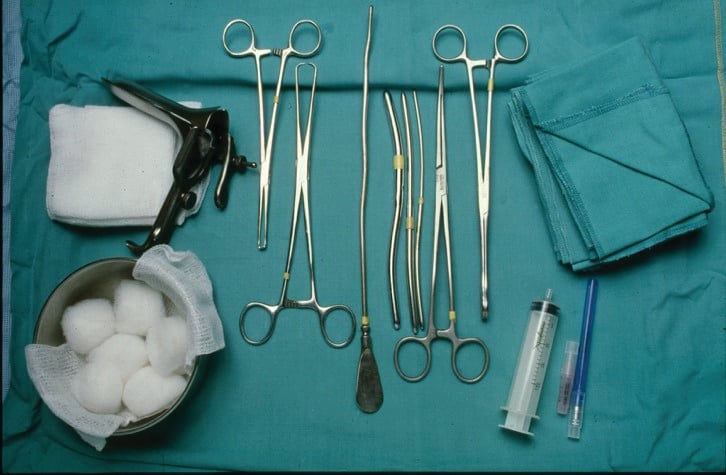In 2008, the Abortion Law Reform Act1 was passed through Victorian Parliament. This effectively removed abortion from the Victorian Crimes Act and legalised it throughout the state. A medical practitioner can be a conscientious objector, but must refer the patient onto a clinician who is able provide appropriate medical assistance.2 The complex political and social debate that surrounds abortion care, access and service provision will be an ongoing challenge. We need to advocate on behalf of women to provide the best possible abortion care. It is also important that our trainees have access to training opportunities.
The current RANZCOG curriculum mandates training in surgical management of miscarriage and abortion. Most trainees will have exposure to surgical management of first-trimester miscarriage (less than 13 weeks) during their Integrated Training Program (ITP) training. With medical termination (using MS-2Step, a combination of mifepristone and misoprostol) becoming more accepted by women and providers, trainees should obtain adequate exposure to the management issues associated with abortion care in the first trimester.
Table 1. Number of cases completed during six-month Advanced Training Module.
| Case | Numbers |
| Complex contraception consults | 20 |
| Complex abortion care consults | 30 |
| Ultrasound cases | 180 |
| Surgical abortion (<14 weeks) | 170 |
| Dilation and evacuation (>14 weeks) | 40 |
Opportunities for training often become more limited from the second trimester. Many trainees will not have the scope of practice to be able to confidently perform mid-trimester abortion (after 14 weeks gestation). Coupled with often difficult access to service providers, women may find themselves with limited options if they seek an abortion after 14 weeks gestation. Non-availability of abortion services has been shown to increase maternal morbidity and mortality.3 Adequate services can only occur if trainees are able to gain the skill set required to support those services, hence the increased need for upskilling in surgical abortion care.
Dilation and evacuation (D&E) is a surgical technique that involves dilation of the cervix and subsequent evacuation of the uterus, by using destructive instruments and a suction catheter. Data are scarce on the number of D&E procedures performed in Australia and access to abortion after 14 weeks is limited, depending on geographical location. The alternative to surgery is a medical abortion, which includes cervical priming with either a laminaria tent and/or mifepristone or misoprostol administration, with a subsequent induction of labour.
Internationally, 10 to 15 per cent of induced abortions occur in the second trimester.4 Literature suggests that D&E results in fewer adverse events than medical induction for second-trimester abortion.5 Practice varies widely according to country, for example, D&E is used for 96 per cent of abortions in the second trimester 6 in the US, and 75 per cent in the UK.7 In Sweden and Finland, contrastingly, nearly all abortions in the second trimester are performed medically.8
As an abortion procedure, D&E results in lower reports of pain and fever, and has a shorter hospitalisation time.9 However, due to the specialised nature of the procedure, providers need to undergo training and maintain an adequate caseload to be safe providers. Due to that limitation, RCOG guidelines recommend that inexperienced providers use medical induction of labour for second-trimester abortion, as it is also effective and well tolerated.10
Historically, there have been concerns regarding increased risk of preterm birth with subsequent pregnancies after cervical surgery (for example, cone biopsies or multiple large loop excision of the transformation zone [LLETZ] procedures). Although there have been no randomised controlled trials, the data from recent retrospective studies suggest that there is no increase in rates of preterm birth after surgical D&E.11 12

Equipment prepared for a surgical abortion procedure.
I commenced my training in 2010 at the Mercy Hospital for Women in Melbourne. As a hospital with a Catholic affiliation, we provide abortion care and counselling at the Austin Family Planning Clinic, located on the same campus. This clinic, led by A/Prof Sonia Grover, services the northern suburbs of Melbourne, with an emphasis on the regional and rural communities in the north. The team includes three nurses, four gynaecologists and a senior general practitioner, with a clinic session once a week and a theatre session once a fortnight.
In 2014, the RANZCOG Women’s Health Committee highlighted the need for a streamlined training pathway for sexual and reproductive health, to improve access to abortion services. I was fortunate to be part of the pilot for the Contraception Care and Abortion Care components of the Sexual and Reproductive Health Advanced Training Module (ATM), in 2016.
This innovative ATM was provided through the Royal Women’s Hospital in Melbourne, under the guidance of Dr Paddy Moore and her team. The aim was to equip trainees with the skill set to confidently provide surgical and medical abortion care in their practice. Available to trainees undertaking the Generalist Stream, the ATM can be completed in combination with general obstetric and gynaecology rotations.
The training components were designed to be completed over a six-month period, with a set number of surgical procedures, ultrasound sessions and counselling sessions undertaken to receive the certification. At the Royal Women’s Hospital, the Pregnancy Advisory Service is the state referral base for women requesting abortion care and covers a wide catchment area. Training access included three theatre sessions and four clinic sessions a week.
We have had an excellent response from trainees with an interest in upskilling and providing the surgical expertise to their communities. The work is very rewarding. I have found that about 30 procedures are required for competence in D&E. This may not be easily achievable in a peripheral hospital, but most tertiary referral centres would be able to provide that number of procedural training opportunities. There are plans to expand the ATM to include an online resource to supplement the on-site training and, potentially, roll the module out to interstate sites and New Zealand. Teaching has been a key part of the module and providing upskilling to general practitioners has been a vital part of improving service provision for abortion care.
With the ongoing guidance of the Women’s Health Committee, I hope that this ATM will continue to provide Fellows with the skills and knowledge base required to provide abortion care in the second trimester with confidence.
For queries regarding the Contraception Care and Abortion Care components of the Sexual and Reproductive Health ATM, please contact Dr Paddy Moore.
Acknowledgement
Many thanks to Dr Paddy Moore for reviewing this article and for providing invaluable assistance.
References
- Abortion Law Reform Bill 2008: Explanatory memorandum. Australasian Legal Information Institute.
- Abortion Law Reform Bill 2008: Explanatory memorandum. Australasian Legal Information Institute.
- World Health Organization. Unsafe abortion: global and regional estimates of incidence of unsafe abortion and associated mortality in 2000. 2012.
- Medical methods for termination of pregnancy. Report of a WHO Scientific Group. World Health Organization Technical Report Series. Geneva: World Health Organization, 1997; Vol. 871.
- Grimes DA, Smith SM, Witham AD. Mifepristone and misoprostol versus dilation and evacuation for midtrimester abortion: a pilot randomised controlled trial. BJOG 2004;111:148-53.
- Strauss LT, Herndon J, Chang J, et al. Abortion surveillance-United States, 2002. Morbidity and Mortality Weekly Report 2005;54:1-31.
- Government Statistical Service. Abortion statistics, England and Wales: 2005. Statistical Bulletin 2006/01 July 4, 2006.
- STAKES. Official statistics of Finland. Induced abortions and sterilisations 2005. Statistical summary 2006.
- Grimes DA, Smith SM, Witham AD. Mifepristone and misoprostol versus dilation and evacuation for midtrimester abortion: a pilot randomised controlled trial. BJOG 2004;111:148-53.
- Royal College of Obstetricians and Gynaecologists. The care of women requesting induced abortion. London: RCOG Press, 2004
- Kalish RB, Chasen ST, Rosenzweig LB, et al. Impact of mid-trimester dilation and evacuation on subsequent pregnancy outcome. Am J Obstet Gynecol. 2002 Oct;187(4):882-5.
- Kalish RB, Gupta M, et al. Obstetric outcomes after surgical abortion at > or = 20 weeks’ gestation. Am J Obstet Gynecol. 2005 Sep;193(3 Pt 2):1161-4.






Leave a Reply